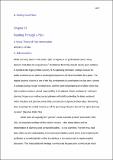| dc.contributor.author | Ryan, Brent D. | |
| dc.date.accessioned | 2013-04-25T19:16:58Z | |
| dc.date.available | 2013-04-25T19:16:58Z | |
| dc.date.issued | 2011-10 | |
| dc.identifier.issn | 0194-4363 | |
| dc.identifier.issn | 1939-0130 | |
| dc.identifier.uri | http://hdl.handle.net/1721.1/78607 | |
| dc.description.abstract | Problem: Planners may read plans often, but the profession continues to view the interpretation of plan content as something that is either too obvious or too unimportant to require explicit discussion. Plans are seldom adequately interpreted. This is regrettable because plans contain a rich variety of content and meaning.
Purpose: This article calls for planners to “read through” plans, not just to grasp their essential ideas or the means of implementing those ideas, but also to perceive additional levels of meaning relating to a) a plan's place within a larger intellectual sphere, b) a plan's statement on the social and political values of the time, and c) a plan as a part of the history of the planning profession and the life of cities.
Methods: I propose a visual approach to plan reading descended from Panofsky's (1939) theory of iconology and use this to examine three very different plans that describe different size cities (small, large, very large) during different periods over the past 80 years (the 1930s, 1960s, 2000s). I analyze three levels of meaning in each plan: its factual meaning, or “plain sense” (Mandelbaum, 1990); its contextual meaning, or relation to political, social, economic, and physical conditions; and its temporal meaning, or setting within the scope of observations made by other plan readers in the perspective of elapsed time.
Results and conclusions: Factual readings show that information may be found in diverse aspects of a plan document, from seemingly superficial aspects like its cover to unarguably central elements such as recommendations. Factual readings depend on understanding the relationships among different elements, and reveal information about the plan and its framers that may not otherwise be readily apparent. Contextual readings show us that plan recommendations are as much a product of contemporary conditions and norms as they are of plan-specific “survey and diagnosis” (Nolen, 1936). This raises the question of whether plan quality is to be judged only in terms of skillful execution of concerns of the day or whether innovation is also important. Temporal readings reveal that plans and planning have changed dramatically over time, simultaneously confirming and questioning the conventional wisdom of planning history.
Takeaway for practice: Many planners read plans on a regular basis, and plans continue to constitute the major printed currency of the planning profession. Both plans and planning will benefit if planners become more discerning readers of the profession's principal idea vessels. Formal plan interpretation is rare, but each planner can become a better plan interpreter. | en_US |
| dc.language.iso | en_US | |
| dc.publisher | Taylor & Francis | en_US |
| dc.relation.isversionof | http://dx.doi.org/10.1080/01944363.2011.616995 | en_US |
| dc.rights | Creative Commons Attribution-Noncommercial-Share Alike 3.0 | en_US |
| dc.rights.uri | http://creativecommons.org/licenses/by-nc-sa/3.0/ | en_US |
| dc.source | Ryan via Peter Cohn | en_US |
| dc.title | Reading Through a Plan: A Visual Theory of Plan Interpretation | en_US |
| dc.title.alternative | Reading Through a Plan: A Visual Interpretation of What Plans Mean and How They Innovate | en_US |
| dc.type | Article | en_US |
| dc.identifier.citation | Ryan, Brent D. “Reading Through a Plan.” Journal of the American Planning Association 77.4 (2011): 309–327. | en_US |
| dc.contributor.department | Massachusetts Institute of Technology. Department of Urban Studies and Planning | en_US |
| dc.contributor.approver | Ryan, Brent | |
| dc.contributor.mitauthor | Ryan, Brent D. | |
| dc.relation.journal | Journal of the American Planning Association | en_US |
| dc.eprint.version | Author's final manuscript | en_US |
| dc.type.uri | http://purl.org/eprint/type/JournalArticle | en_US |
| eprint.status | http://purl.org/eprint/status/PeerReviewed | en_US |
| dspace.orderedauthors | Ryan, Brent D. | en |
| dc.identifier.orcid | https://orcid.org/0000-0002-0223-1887 | |
| mit.license | OPEN_ACCESS_POLICY | en_US |
| mit.metadata.status | Complete | |
